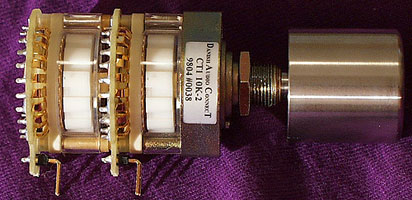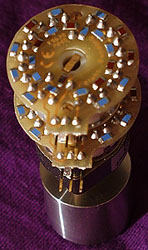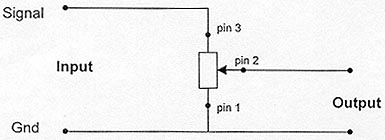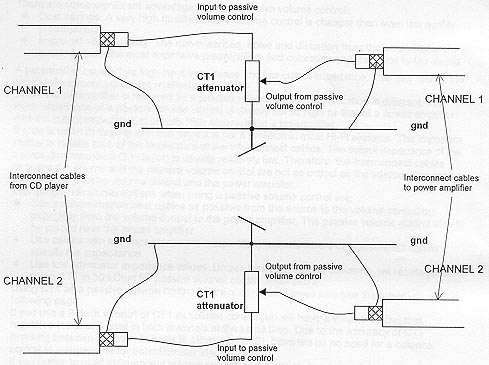It is the K.I.S.S.
method. Keep It Simple Stupid. Virtually nothing is more simple
than a passive device to adjust the volume of your music reproduction
system. In fact virtually every system has an audio attenuator in
it! So why do you really need all those other parts in the
signal's path to possibly add noise and distortion to the audio
signal? Why, too, the added expense of of other parts when a simple
less than $200 project can be considered by some as inherently better than
a $4,000 active preamplifier? Is all perfect in the Land of
Attenuators (L.A.)? Maybe... maybe not. And even if you have a great
preamplifier now, how about a great way to possibly enhance it for only
$200?
The virtues of passive
attenuation has long been known. Since most source components like
CD/DVD players and turntable preamplifier output two volts or more, they
generally have enough power to "drive" most amplifiers. The "trick" is
to simply keep your interconnect lengths as short as possible while keeping
the output impedance of the source component at least a multiple of hundred
smaller than the input impedance of your amplifier. To better clarify, if
your CD player has an output of two volts at 200 ohms, the amplifier should
have an input that maxes out at 2 volts with an input rating of 20,000
ohms. Since these type of rating are the norm, there is really very
little to worry about here. Allen Isaksen of DACT replied to me in an
e-mail "The passive preamp is also to be considered as a source - it
is the source for the power amplifier. The source impedance when using
a passive preamp is higher than you would normally like it to be. In
your case, where you use a 10kOhm CT1, the source impedance (attenuator
output impedance) will vary between 0 and 5kOhm depending on the volume
setting. This is really far from ideal, but as long as the load impedance on
the passive preamp is either purely resistive or at least the capacitive or
inductive component of the load impedance is very small, it still works. In
practice you will obtain very good results from using a passive
preamplifier because the power amplifier normally has a purely
(nearly) resistive input impedance. So all you have to consider is the
capacitance of the cable connecting the passive preamplifier and the power
amp. Therefore, you want to look for cables with low capacitance per
meter and you also want to make them as short as possible. Based on the
above it is obvious that 5kOhm attenuators (or even lower impedance's)
would be better for passive preamps. Unfortunately, that is not practical
because if the attenuator impedance is reduced to less than 10k, the
load on the CD player output becomes too tough - many CD players cannot
deliver the required current. In conclusion: 10kOhm attenuators are normally
the best compromise for passive preamps."
In fact many of the new
breed of highly praised integrated amplifiers use a simple passive
attenuator circuitry for volume adjustment! Seen below is the Danish Audio C onnecT (DACT) CT1 10K-2 stereo audio
attenuator with optional CT-knob1 stainless steel knob. Because this
project is for a pure passive unit, the 10K rating was chosen for its low
impedance. Higher impedance ratings are good for those replacing their
active preamplifier's volume potentiometer.
 |
The DACT CT1 uses extremely
accurate surface mount  devices (SMD) metal film resistors for
24-step attenuation. As seen to the right, the small blue and dark
brown squares are the actual SMD metal film resistors. SMD devices are
used in the military for their extremely high precision. In fact
they are accurate within
.05db! Because SMD are very small, the signal's path is about five
times smaller than other typical non-SMD units. If there is one
thing i have learnt over the years, it is that the shorter the signal
path the better. DACT also used very close attention to the design and
layout of the parts as they are mounted to the circuit board to insure
very low series inductance and very low stray capacitance.
Furthermore, all contacts are gold plated while the rotary switch itself in
manufactured in Switzerland. DACT left no aspect to chance in
their top-quality design. Because of the unit's accuracy, DACT claims the
distortion of their units are an amazing .0001%!
devices (SMD) metal film resistors for
24-step attenuation. As seen to the right, the small blue and dark
brown squares are the actual SMD metal film resistors. SMD devices are
used in the military for their extremely high precision. In fact
they are accurate within
.05db! Because SMD are very small, the signal's path is about five
times smaller than other typical non-SMD units. If there is one
thing i have learnt over the years, it is that the shorter the signal
path the better. DACT also used very close attention to the design and
layout of the parts as they are mounted to the circuit board to insure
very low series inductance and very low stray capacitance.
Furthermore, all contacts are gold plated while the rotary switch itself in
manufactured in Switzerland. DACT left no aspect to chance in
their top-quality design. Because of the unit's accuracy, DACT claims the
distortion of their units are an amazing .0001%!
 Making your own passive attenuator box is
actually quite easy. All that is needed are four female RCA
plugs, some wire, solder, a 1 Meg Ohm series resister (ensures
dissipation of any static charges), and a metal box. i won't get
into the step by step building details here as these diagrams give virtually
all the data needed. The 1 Meg Ohm resistor goes in series with the
ground wires. Simply said, the entire project took me about 3
hours.
Making your own passive attenuator box is
actually quite easy. All that is needed are four female RCA
plugs, some wire, solder, a 1 Meg Ohm series resister (ensures
dissipation of any static charges), and a metal box. i won't get
into the step by step building details here as these diagrams give virtually
all the data needed. The 1 Meg Ohm resistor goes in series with the
ground wires. Simply said, the entire project took me about 3
hours.

Once i had my unit built
and tested, the first thing i noticed was that the music seemed to "time"
better. To put it another way, the bass, midrange, and treble
seemed to be better synchronized together. While not a huge difference,
as a drummer for many year i tend to notice any change in
timings of events within music reproduction. Some people say that
passive volume takes away the drive from a music reproduction
system. With the DACT CT1 in my system the opposite seemed to be
true! It was also as if a veil was lifted from the music as
well.
While i have a few
different preamplifiers here (both solid-state and tubed), the tube
unit i have here seems to give a more 3D soundstage at the expensive
of ultimate clarity and imaging precision. Plus the tubed unit has a
bit fuller lower frequency response as compared to the DACT
CT1. Still, there were times i personally preferred the more
dimensional tubes unit over the added clarity and seemingly more
neutral DACT CT1. i found the DIY passive preamplifier to be so transparent
that i was able to hear a greater amount of small inflections in music
recordings that no other preamplifier here could resolve!
The CT1 is very
chameleon-like as any great preamplifier should be. During monophonic
recordings the image had depth when it was in the recording, yet the
image was very solidly placed directly between the speakers. On modern
stereo recordings like Chesky's O Magnum Mysterium (JG83), which is a
great record with 3D-like ambience, the sound of the hall ambience came well
into the room with a sense of height and depth only the best
preamplifiers could challenge. This recording is very highly
recommended as only the best systems will give you that full surround
sound-type experience. While still a bit foreshortened in frontal depth and
not as full in the midbass/lower midrange as compared to my beloved
tweaked out Audio Note M2 silver-wired tubed preamplifier, the imaging with
the CT1 was more pinpoint. As for which is "better", this could
be considered as more of a preference than a "which is better or
worse" in my humble opinion. Tonally, the CT1 seemed quite good
indeed. Very neutral sounding vs. the slight midbass boost and either
over sweetening or the boosting of the highs some people seem to
prefer.
As for speed and attack,
there was nothing i had on-hand that came even close to the CT1. This
made sense as there really is not much to the CT1 and therefor less =
more. King Records Sankyoku - Traditional Japanese Music (KICK 2007)
is recorded using traditional Japanese instruments (shakuhachi,
shamisen, and koto). Anyone who has had the pleasure to hear
traditional Japanese music live knows the light-speed attack yet
subtle finesse these instruments have. For it is only the very talented
musician that can play such instruments within the musical structure
correctly. This is where the CT1 is at the top of it's class!
Nothing comes even close the the speed of the CT1.
When it came to deep bass,
the CT1 was very balanced through the last few lowest octaves. While i
prefer a bit more fullness in the midbass region (60 Hz - 200 Hz), one can
not help but admit the balance of the music octave to octave. As
for uppermost frequencies, there seemed to be a light sweetness yet
impressively extended sound. The highly regarded Water Lily Acoustics
CD A Meeting by the River (WLA-CS-29-CD) is a great example of upper
frequency extension. In fact there were times with other preamplifier i
felt there was a little extension missing within this recording. Well,
with the CT1 as a passive preamplifier there seemed to be just the right
amount of extension on the topmost octaves. Amazing how a simple
passive volume control can make all the difference! Viva la
difference!
DACT also makes attenuators
which can be used to substitute for pre-existing volume potentiometers
in various active preamplifier units. Word on the streets is that
plastic film-type units add a veil to the music and also a thickening of the
lower frequencies of the music. Is this the difference i am hearing
with my beloved tubed preamplifier? Possibly. My friends who has
substituted their stock potentiometers with a DACT all seem to feel that
very good improvements in clarity and imaging were the main result.
One of my friends swears his $2,000 DACT'ed preamplifier now rivals
those in the $4,000 range! While i can not argue with him there, i
will say that including labor costs the changing of a stock Alps, Noble,
Burnes, etc. to the DACT should cost around $200 (including a technician's
labor expense) and possibly achieve a performance boost worth multiples of
dollars!
In the end there is no
doubt in my mind the advantage of going purely passive volume adjusting with
an audio attenuator. The main caveat is that interconnect wire
lengths should be kept at a minimum while some attention is paid to the
input and output impedances of your components as discussed earlier in this
article. DACT also makes very high quality input selectors too by the
way. Therefor a multi-input passive volume unit can easily be made if
you so desire. In fact if you are very handy and have only one
source component, you could potentially just drill the appropriate
sized hole in the front of your amplifier and install the DACT CT1
directly on your amplifier! i can not stress enough that anyone whose
preamplifier uses a film-type potentiometer could also achieve a healthy
dose of added transparency and imaging simply by switching to a DACT audio
attenuator. Though the signal path is only gold plated, in my
humble opinion the DACT is worth it's weight in gold! Need i say
more?
|
Tonality |
80 |
|
Sub-bass
(10 Hz - 60 Hz) |
80 |
|
Mid-bass
(60 Hz - 200 Hz) |
75 |
|
Midrange
(200 Hz - 3,000 Hz) |
75 |
|
High-frequencies
(3,000 Hz on up) |
85 |
|
Attack |
90 |
|
Decay |
90 |
|
Inner
Resolution |
90 |
|
Soundscape
width front |
85 |
|
Soundscape
width rear |
90 |
|
Soundscape
depth behind speakers |
80 |
|
Soundscape
extension into the room |
90 |
|
Imaging |
95 |
|
Fit
and Finish |
95 |
|
Self
Noise |
100 |
|
Value
for the Money |
80 |
CT1-10k-2
$138.30
CT-knob1 $12.70
Danish
Audio Connect
Room 1501/3 Ban Chang Glas Haus Building
1
Sukhumvit Road Soi 25
Bangkok 10110, Thailand
voice
(+66) 2 260 6070
fax (+66) 2 260 6071
http://www.dact.com/
Manufacture's
Reply
DACT
would like to thank Steven Rochlin and Enjoy the Music.com for the
thorough review of our CT1 Audio Attenuator. Using and reviewing a passive
volume control is not just straightforward. If impedance issues, including
interconnecting cables, are not dealt with appropriately, the results
are less than perfect. Steven Rochlin's review clearly proves that he
knows what he is doing. As a result, he manages to avoid potential
passive-preamp-problems and instead reveals the improvements that are
possible using a simple passive preamp based on a high quality audio
attenuator.
For those, who for some reason are not able to use a
passive preamp (maybe long signal cables to the power amp are
required), we are soon able to offer a solution. At the moment DACT is
working on a very small linear amplifier module which we call CT101.
CT101 will have very low output impedance and will match the spec's
and sonic qualities of CT1. Release of CT101 is expected to be
September/October this year (1999). With respect to replacing standard
potentiometers by CT1 attenuators we can only support the comments made in
the review. All customer feedback we have received says that the improvement
is very significant.
Allan
Isaksen, Danish Audio ConnecT
Copyright© 1999
Enjoy the Music.com™
All rights
reserved.